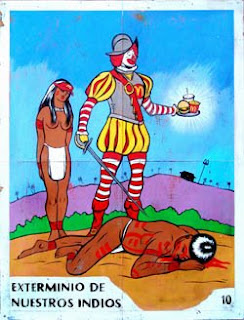 If you happen to be in the neighborhood of the Philagrafika offices, we want to let you know that you are also welcome to come pick up a free copy of Pointe d’Ironie during your visit. This colorful 8-page spread is a French artist publication that periodically (somewhere between two and six times a year) gives free reign to an artist to fill tabloid-sized pages that will be printed en masse and distributed without charge all around the world. We get 25 copies here at the office every time it comes out, but we also suggest you take a good look at what they are doing more generally – they have a compelling approach to the art object, and to the value of the artist's name.
If you happen to be in the neighborhood of the Philagrafika offices, we want to let you know that you are also welcome to come pick up a free copy of Pointe d’Ironie during your visit. This colorful 8-page spread is a French artist publication that periodically (somewhere between two and six times a year) gives free reign to an artist to fill tabloid-sized pages that will be printed en masse and distributed without charge all around the world. We get 25 copies here at the office every time it comes out, but we also suggest you take a good look at what they are doing more generally – they have a compelling approach to the art object, and to the value of the artist's name.
In brief, the publication is co-edited by French fashion designer Agnes B. and Swiss curator Hans-Ulrich Obrist. The paper can be used or enjoyed at the viewer’s discretion: according to an interview with contributor Christian Boltanski, some have used it as wallpaper, others have used it as wrapping paper during the Christmas season, and still others have just thrown it away when they were done. The name of the artist is in small print, as is that of the publication, so the average viewer is likely to pick it up because they find it aesthetically intriguing and not because they know it is a Yoko Ono or Damien Hirst (both contributing artists). There is also quite a bit of information on the concept of the Pointe d’Ironie itself: it’s a reversed question mark symbol that the French poet Alcanter de Braham invented at the end of the 19th century to indicate sentences that should be read on more than one level of signification. So, the publication is surrounded by interesting people and ideas, and now it is also available at Philagrafika!
name of the artist is in small print, as is that of the publication, so the average viewer is likely to pick it up because they find it aesthetically intriguing and not because they know it is a Yoko Ono or Damien Hirst (both contributing artists). There is also quite a bit of information on the concept of the Pointe d’Ironie itself: it’s a reversed question mark symbol that the French poet Alcanter de Braham invented at the end of the 19th century to indicate sentences that should be read on more than one level of signification. So, the publication is surrounded by interesting people and ideas, and now it is also available at Philagrafika!
Since this blog is already about self-promotion, we thought we would also let you know about the new installation that is going up in Space 1026, One Long Funeral Song, opening to the public starting this Friday. The artist is Monica Canilao, whose work was also featured in the Justseeds show we blogged about last week. And, while you are in that neighborhood, before that opens at 7 pm at the Fabric Workshop, Ed Ruscha: Industrial Strength and the reopening of the AIA Bookstore 1218 Arch Street, Philadelphia. Check out artblog's What We Want to See Friday article here for other exhibitions in that area.
Another show people are talking about is the Extreme Animals (paperrad) along with Buffalo Stance, Mincemeat or Tenspeed, Fortress of Amplitude (David from paperrad) along with poetry by Joe Pereira & DJ Dan Murphy (megawords) all at Pageant Gallery at 6th & Bainbridge at 8:30pm.


















